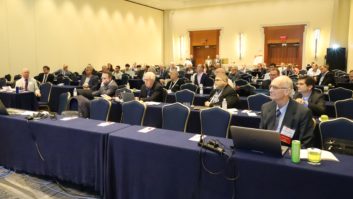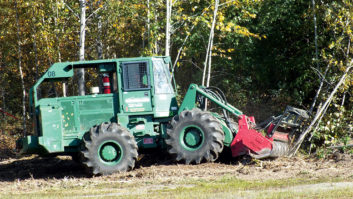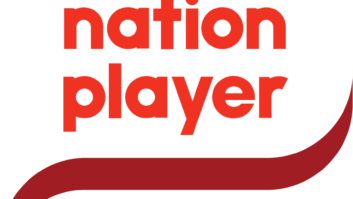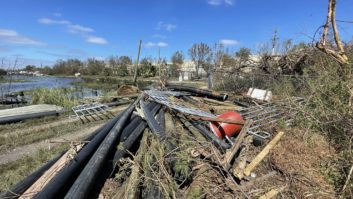I grew up in a small town with no regular local nighttime radio service; early on I became close friends with 50 kW clears in distant cities.
So I wanted to find out if nighttime IBOC transmission would really be the death knell of long-distance AM skywave listening, as some critics believe.
I decided against measuring signal strengths or viewing signals with a spectrum analyzer. The analytical toolset of most radio listeners is a pair of ears.
For receiving equipment I picked a Sangean CCRadio plus with digital tuning and a GE Superradio III (operated in narrow-band mode) — receivers that serious AM listeners might be using. Neither was connected to an outside antenna, and listening took place in the basement level of two homes that I own in the Washington area.
My primary residence is in Alexandria, Va. The home is clad in aluminum siding and is about a mile from an AM station. There were fluorescent lighting fixtures, an X-10 carrier current remote control system and two computers in operation during most of the AM listening. A 14.4 kV power line passes the house, and there are three 230 kV high-tension lines two blocks away.
My country home is about 50 miles south and west of Washington. It’s set in the woods, but is a modern “all electric” house with its own X-10 control system and numerous standard and compact fluorescents. A 7.2 KV feeder passes the house, and there’s a 500 kV cross-country transmission line less than a mile away.
These conditions are representative of what AM radio signals have to overcome to reach listeners today.
The Sangean radio is tuned to WHAS, Louisville, Ky., at 840 kHz. Alongside is one of the author’s Otari MTR-10 audio recorders used to record ‘before/after’ audio and a rack-mounted Tascam LA-40 unbalanced/balanced audio converter to feed audio from the radios to the Otari. Photo by James O’NealIBOC-free listening
Prior to Sept. 14, the first night the FCC authorized AMs to leave their IBOC transmitters on all night, I logged and recorded signals from more than 50 stations. Although late summer is not the best time for AM reception, I managed to pull down most of the familiar nightimers. These ranged from WGR in Buffalo, N.Y., at 550 kHz all the way up to WQEW in New York City on 1560 kHz.
Stations were received from as far south as WWL, New Orleans; WHO, Des Moines to the west; CHWO, Toronto to the north; and WBZ, Boston to the east. If I couldn’t comfortably listen to a station, it wasn’t logged.
Virtually all stations were common to my two receive sites. The one holdout was WTWP, formerly WTOP, in Washington at 1500 kHz. However, this station has poor Northern Virginia nighttime coverage.
Nothing really spectacular was observed in the three nights of IBOC-free listening.
On the Friday night that AM nighttime broadcasting was supposed to drastically change, my wife and I drove to our country place for some additional DXing.
A front was moving through and brought precipitation ranging from light drizzle to heavy rain.
En route I switched the van’s radio from Sirius Satellite Radio to AM to see if hash was all that was left, but I was rewarded with clear reception of CHWO’s regular Friday night music offering.
The rainy weather and stop-and-go traffic didn’t allow much experimentation, but I observed that WOR, New York was indeed running IBOC and so was WABC in that same city.
WOR handily took down WLW in Cincinnati on 700 kHz and WGN, Chicago at 720 kHz. WABC in New York on 770 kHz made it impossible to listen to adjacents WJR, Detroit at 760 kHz or WBBM, Chicago at 780 kHz.
After reaching our weekend home, I resumed DXing and observed that the only serious damage to nighttime regulars seemed to be what was noted in the en-route listening experience.
With the Sangean and GE radios I could null out some adjacent-channel interference by orienting the sets to favor the Detroit, Cincinnati and Chicago stations. When properly “aimed,” I was able to hear the previously covered-up stations with only minor digital noise.
WOR has always been subject to some serious nighttime fading here and WLW and WGN were completely clear of digital hash during the deep WOR fades. But that is as expected. I don’t own an IBOC-capable receiver, but would have to believe that neither digital nor analog WOR could be received during such fades. (This is borne out by others reporting that the best skywave IBOC lock duration is usually measured in seconds, up to less than a minute.)
Not great radio night
As listening conditions were not that great, I gave up around 1 a.m. A front pushed through overnight and cleared out on Saturday, Sept. 15. Chasing AM signals was a bit better that evening.
Again, I heard WOR and WABC and what they were doing to their first-adjacents. Again, I was able to null out most of the hash.
As “atmospherics” were substantially diminished, I confirmed what I thought I’d perceived the night before: the noise floor on both stations had increased from that observed in pre-IBOC nights.
With WOR, I believe that was due in part to the self-interfering nature of AM IBOC aided by a contribution from adjacent WLW. I’m not sure that WABC had much help in this respect, as it was whacking 780 WBBM worse than WBBM was clobbering it.
I noted several other implementers, including WTAM, Cleveland on 1100 kHz. Normally WBT, Charlotte, N.C. on 1110 kHz, delivers a gangbuster nighttime signal here, but now WBT was being peppered by IBOC hash. As Charlotte is at nearly a right angle from Cleveland here, I was able to null out most of the trash.
Unfortunately this didn’t work for WBAL, Baltimore at 1090 kHz. WBAL goes N-S directional at night and doesn’t put much of a signal in here. WTIC in Hartford, Conn., on 1080 kHz is running IBOC 24/7, hammering WBAL from both sides. The station was previously audible, but now was not.
WLAC, Nashville, Tenn., at 1510 kHz; WWKB, Buffalo, N.Y., at 1520 kHz; and WCKY, Cincinnati at 1530 kHz were completely in the clear. WTWP, Washington on 1500 kHz was not running IBOC.
For grins, I checked into WQEW, New York at 1560 kHz to see if nighttime IBOC had done any damage to Radio Disney. No such luck! It was totally unscathed.
Skywave is variable
For several months WHAS, Louisville, Ky., at 840 kHz, has run a nighttime ID proclaiming that it was broadcasting in HD. Now they were really pushing out the additional nighttime spectrum baggage.
WCCO, Minneapolis at 830 kHz was much weaker, and with both stations close to the same compass heading, WCCO was not really listenable.
Chicago’s WLS on 890 kHz is running IBOC. This was evidenced by a definitely noisier WCBS, New York at 880 kHz.
New Orleans’s WWL at 870 kHz really blasted in here (probably second only to Boston’s WBZ) and didn’t seem to be much affected by the IBOC blitz.
Listening to WJR as I wrote this, at about 10:30 p.m. on Sept. 17, the fourth night of skywave IBOC, I was somewhat amazed at the will-o’-the-wisp nature of the beast. On Sept, 16, WJR, Detroit was getting clobbered by WABC, New York, but the next night, even without too much nulling exercise, the Detroit signal was fairly clear. Ditto WBBM, Chicago. It was WABC that was suffering.
Of course, due to nighttime medium wave fading nature, there are no absolutes.
So what’s the verdict? Did nighttime IBOC kill skywave broadcasting?
I have to say that it’s still inconclusive. As I listened Sept. 17, I really didn’t hear that much interference. True, WBAL was gone and WBT was being peppered, but at home I can null out WTAM.
On the other hand, this isn’t possible with a car radio. I imagine that East Coast Cincinnati Reds and Chicago Cubs fans trying to listen to nighttime home team broadcasts while driving are going to be disappointed.
RW welcomes other points of view and readers’ field observations about digital radio. Write to [email protected].













